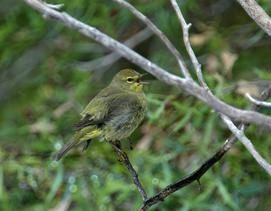ORANGE-CROWNED WARBLER OR-361
Willamette Valley, William L. Finley National Wildlife Refuge, Oregon
May 23, 5:18 a.m.
Sunrise at 5:37 a.m.
Singing from a bush on the forest floor, well before sunrise, in the dark, who is this? My brain feels a bit addled, and I cannot comprehend how this can be an orange-crowned warbler. They sing from the tree tops, and never have I heard one so low. Chipping sparrows sing low at dawn, but an orange-crowned warbler? Feeling quite confident there's nothing else this singer could be, I accept him for who he seems to be, and look forward to encountering more of these warblers at dawn, to learn more about their dawn activities.
That song at 0:32 really intrigues me. Simultaneous with the song, beginning 2/100th of a second before to 5/100th of a second after, are wing beats--a bird is flying, or at least flapping its wings. I can see the increased irregularity in his song, with some wavering of frequencies, so I know it is this warbler flapping his wings and exerting enough effort as he sings so as to ruin the precision with which he normally delivers.
Rather than beating the air from his perch in some kind of grouse-like display, he must be simply flying in the dark, his destination not exactly sure, and hence the labored flight, the rate of wing flapping perhaps a little low for a bird this size (15 beats/second).
Background
Swainson's thrush, song sparrow, mourning dove, American Robin, red-breasted nuthatch.

Photo by John Van de Graaff
